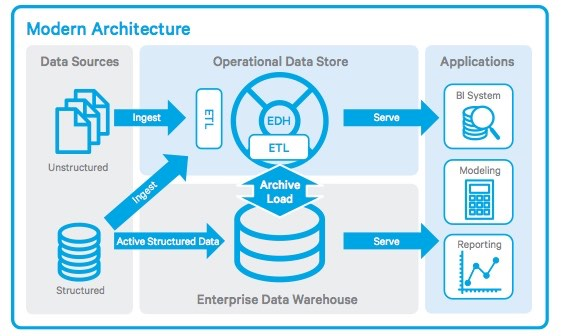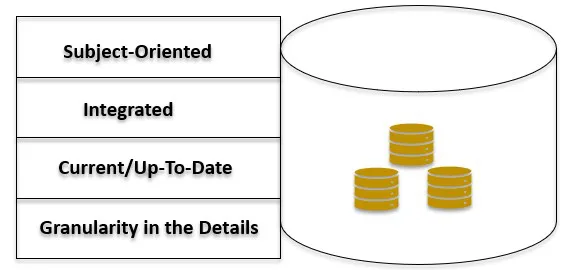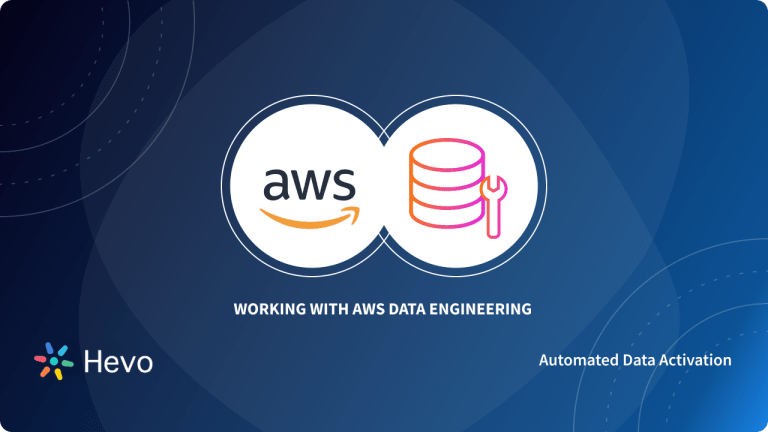Ever feel like your data is scattered across different systems, making it challenging to get a clear, up-to-date view of what’s happening? That’s where an Operational Data Store (ODS) comes in. It acts as a centralized hub, pulling real-time data from various sources so you can access everything in one place, without waiting for overnight updates or sifting through multiple databases. In this blog, we’ll explore how an ODS works and why it’s essential for businesses looking to make quicker, more informed decisions.
Table of Contents
What is Operational Data Store?

An Operational Data Store (ODS) is a central database designed to provide a snapshot of the most recent data from multiple transactional systems, primarily for operational reporting. It allows organizations to combine data from various sources in its original format, bringing it together in one place. This real-time data consolidation makes it easier for businesses to access up-to-date information without waiting for batch processing. Unlike a data warehouse used for historical analysis, an ODS focuses on delivering fresh data to support day-to-day operations and quick decision-making.
Key Features of Operational Data Store
Here are some key characteristics of an ODS:
- Real-time data: ODSs provide a current snapshot of data, allowing for real-time analysis of business processes.
- Original format: ODSs store raw data from production systems in its original format, without transforming it.
- Data integration: ODSs aggregate data from multiple systems into a single location.
- Data cleaning: ODSs can scrub data, resolve redundancy, and check for compliance with business rules.
- Data presentation: ODSs present data to business intelligence (BI) applications for analysis.
Use cases: ODSs are commonly used for online transaction processing applications, such as managing logistics, tracking orders, and monitoring customer activity.
While ODSs are well-suited for real-time reporting, they may not be the best option for complex queries or historical data analysis. ODSs can also be high maintenance and volatile, and scaling them can be difficult.

An Operational Data Store contains atomic or indivisible data, such as prices and transactions, that are captured in real time and thus have a limited history. As such, this type of database is a location that preserves data used in recent functions. After integration, it is relocated to a Data Warehouse’s permanent storage systems or archives.
A fully-managed No-code Data Pipeline platform like Hevo Data, helps you load data from 150+ different sources to a destination of your choice in real-time in an effortless manner. Hevo with its minimal learning curve can be set up in just a few minutes allowing the users to load data without having to compromise performance.
Get Started with Hevo for FreeIts strong integration with umpteenth sources provides users with the flexibility to bring in data of different kinds, in a smooth fashion without having to code a single line.
A few Salient Features of Hevo are as follows:
- Completely Automated: The Hevo platform can be set up in just a few minutes and requires minimal maintenance.
- Real-Time Data Transfer: Hevo provides real-time data migration, so you can have analysis-ready data always.
- 100% Complete & Accurate Data Transfer: Hevo’s robust infrastructure ensures reliable data transfer with zero data loss.
- Scalable Infrastructure: Hevo has in-built integrations for 150+ sources that can help you scale your data infrastructure as required.
- 24/7 Live Support: The Hevo team is available round the clock to extend exceptional support to you through chat, email, and support calls.
- Schema Management: Hevo takes away the tedious task of schema management & automatically detects the schema of incoming data and maps it to the destination schema.
- Live Monitoring: Hevo allows you to monitor the data flow so you can check where your data is at a particular point in time.
Characteristics of Operational Data Store Systems
Here are the attributes of Operational Data Stores(ODS):
- ODS systems are highly available and fault-tolerant.
- They occupy less space due to the compression of data and operations.
- ODS systems host configurable, easily accessible, and fast real-time comprehensive data.
- ODS systems are connected to one or more data sources.
- They do not host large amounts of historical data, and thus cannot handle huge data transactions.
- An ODS system makes the creation of back-ups and recovery processes effortless since the size of the data is small.
Use Cases of Operational Data Store Systems
The main purpose of an ODS is to integrate data from diverse source systems into a single entity, through technologies such as Extract, Transform and Load (ETL), Data Federation, or Data Virtualization.
Implementation of Operational Data Stores

In the creation of an Operational Data Store, multiple data sources can be integrated. However, each data source system must have the following principles to qualify:
- Subject-Oriented: The design of the Operational Data Store should be built based on the business’s functional requirements, especially in regard to a specific area under discussion.
- Integrated: All the data from diverse sources must undergo the ETL process, which involves cleaning junk for redundancy, data transformation into a single format, and loading of the dataset into the ODS as indicated by the business policies for control and regularity of data.
- Up-to-Date: The ODS data should be current and thus updated to host all recent functions of the application connected to the Data Warehouse, as well as to depict the data’s existing status from each Data Warehouse linked source.
- Detailed: As the rules are implemented, it is crucial to maintain the business’s comprehensive detailing level for the proper execution of respective functions, which are mainly supporting the operational business requirements or functions.
Data Warehouses vs Operational Data Stores
The general purpose of an Operational Data Store is to integrate corporate data from multiple heterogeneous data sources to enable operational reporting in real-time or near-real-time. An Operational Data Store is normally used as a data source for the Data Warehouse.
Let’s delve further into how does an Operational Data Store differs from a Data Warehouse:
- Granularity: An Operational Data Store is utilized for the lowest granular queries whereas a Data Warehouse is used for more complex queries against a summary level or else on aggregated data.
- Reporting: An Operational Data Store is used for the purpose of operational reporting and supports current or near-real-time reporting requirements whereas the purpose of a Data Warehouse is historical and trend analysis reporting on voluminous data.
- Data Storage: An Operational Data Store is capable of holding a small window of data whereas a Data Warehouse is capable of storing the entire history of data.
- Decision Process: An Operational Data Store is responsible for providing the information for tactical and Operational Decisions on either current or near-real-time data whereas a Data Warehouse deals with feedback delivery for strategic decisions that eventually lead to overall system improvements.
- Load Frequency: In an Operational Data Store, the frequency of the data load can range from every few minutes to hourly whereas in a Data Warehouse the frequency of the data loads could be daily, weekly, monthly, or quarterly.
Benefits of an Operational Data Store
Operational Data Stores are data repositories that store a snapshot of an organization’s current data. An ODS is capable of delivering the best available instance of a data element at any given moment. An Operational Data Store is beneficial to firms and other entities in multiple ways such as the following:
- An ODS provides access to current and less complicated data, which could be non-aggregated and finely crumbled and can be probed in a suitable approach without the usage of operational systems. To properly acquire data from an ODS, the probing process should not have multi-level joins that make it complicated. Instead, it should include simple queries that are sufficient enough and thus hold detailed operational data moderately.
- The ODS provides inefficient communication information technology systems with a united repository to tap to.
- Since ODS reporting may be more sophisticated compared to individual underlying systems reports, the ODS simplifies matters by providing a better approach. It gives a merged data view that is integrated from numerous systems, and so reports provide a general perspective on operational processes.
- The updated view of the status of operations simplifies the process of diagnosing an entity’s problems before going into component systems. For instance, in a product delivery company, the ODS allows the service representatives to locate a customer’s order and its status, as well as more troubleshooting information that could smoothen operations.
- An ODS works through time-sensitive and vital business rules, including those that automatically alert a financial institution about a customer’s account withdrawal. Such accumulative rules automate processes and thus improve efficiency significantly. Without the current and integrated data, it may be impossible to attain such high levels of efficiency or improve them.
- An ODS does not have historical operations and data, and hence it is a secure option that offers data privacy and is resilient to cyber-attacks.
- Businesses often provide complex requirements to manage the generation of input used in analysis and reporting processes, which propel decision making. Therefore, ODS simplifies these processes by being a practical feasible structural design.
- When there is trouble, such as impromptu restarting of a Database or environmental failure, an ODS conducts a turnaround within considerably less time, and thus reduces business and applications’ stakeholders’ stress.
- The Operational Data Store can query data that is closer to real-time operations, especially when it is needed by reporting and analysis tools.
Why Do Organizations Deploy an Operational Data Store?
Deploying an Operational Data Store brings in many added benefits to the organisations, like:
- Data Aggregation: Organizations use and depend on a variety of systems to create and preserve records. Keeping such application data seperate leads to creation of data silos. Operational Data Stores consolidate all data into a single unified view for greater clarity and comprehensibility.
- Comprehensive Reporting: Some systems have restricted reporting capabilities by design. ODS addresses this by allowing users to combine data from several sources and provide detailed reports.
- More User Access: Sometimes access to database or record systems is usually restricted to a select few users. But using ODS, you get to expand the organization’s reporting capabilities to a larger audience and not only to those select few.
Conclusion
Modern organizations should have Operational Data Stores as part of their data stack since from the evidence presented in this post, such a system acts as a Central Database System that deals with data from multiple sources and organizes it into a single format through a series of ETL operations. It makes current data analysis easier and hence decision-making becomes less complicated. Therefore, it can be seen that an organization’s performance partially depends on how it handles its data and the data management systems that they employ.
For any information on OLTP vs OLAP, you can visit the former link.
Visit our Website to Explore HevoExtracting complex data from a diverse set of data sources can be a challenging task and this is where Hevo saves the day! Hevo Data offers a faster way to move data from 150+ Data Sources like Databases or SaaS applications into your Data Warehouse to be visualized in a BI tool. Hevo is fully automated and hence does not require you to code.
Want to take Hevo for a spin?
You can try Hevo for free and Sign Up for a 14-day full-access free trial. You can also have a look at our unbeatable pricing that will help you choose the right plan for your business needs!














